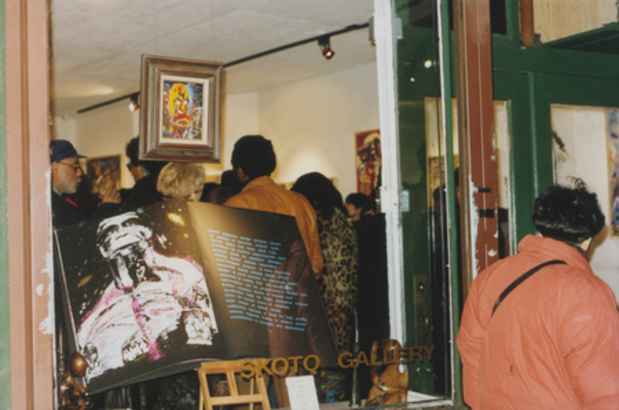"20th Anniversary" Exhibition
Skoto Gallery

This event has ended.
Skoto Gallery at 20
by Geoffrey Jacques
It is tempting to talk about Skoto Gallery as a secret treasure of the New York art scene; but doing so brings up a lot of contradictory data. For instance, how does a “secret” survive two decades in a historically tough scene made even tougher by the cultural and economic head winds that have buffeted art, the New York art world, and the world in general in the last few years? To say the quality of the work shown at Skoto Gallery during these last twenty years is responsible for its success would be one obvious truth. There is, however, more to it than that. Skoto Gallery performs a vital intervention into the very idea of contemporary art.
Twenty years ago this seemed like just another gallery starting up in New York City’s Soho during that neighborhood’s historical heyday as the center of the art world. This was a time of sharp public protests and protest-style exhibitions trying to crack an art scene whose racial and gender homogeneity was only slightly masked by an essentially Eurocentric ethnic plurality. It was the era of a multiculturalism that seemed like it was always emerging, yet never quite arriving. The Museum of Modern Art had recently mounted a highly-touted exhibition on “primitivism” —still thought of, as late as the mid-1980s, as a polite word — and modern art. African art was still thought of, by a wide section of the art public and by more than a few specialists, as an art without artists. That is, one had the objects, but usually these objects had no individual names attached to them. The sources of these objects were often ascribed as tribal or regional, but were rarely ascribed to an individual artist. Of course, Africans might have had some influence on the origins of modern art —this was, after all, MOMA’s point — but none created art worth thinking about in our real-time world. Few people in New York had ever heard of a contemporary African artist making contemporary art. Meanwhile, the conversation concerning contemporary art as such focused almost exclusively on European or Eurocentric trends, individuals and individualists. Even the few African Americans whose names the official art world admitted to knowing, such as Romare Bearden and Jacob Lawrence, were talked about, when considered at all, not as artists, exactly, but as relics or representatives.
This was the art world Skoto Gallery found itself in, and its own intervention into the conversation started with a bang. To open a gallery largely devoted to contemporary African art was one thing, and a pretty big thing at that; but to open the gallery with an exhibition curated by Ornette Coleman was another thing altogether. Soon enough, word got around town that something different was happening down on Prince Street. So it was. You walked in, and a whole new world opened up. It wasn’t just Africans who showed there, as remarkable as that might have been; sometimes Skoto Gallery would come up with ingenious pairings. I remember being so moved by a 1995 exhibition of works by two sculptors that I had to write about them. The pairing was, at first glance, audacious: Tom Otterness, from Kansas, who lived in New York; and Bright Bimpong, from Ghana, who was, at the time, studying in New Jersey. It was the kind of beautiful exhibition we’re now used to seeing at Skoto Gallery. On another occasion, I spent several congenial hours surrounded by the transcendent works of the category-defying El Anatsui, who was born in Ghana but who made his reputation in Nigeria. Here was an accomplished artist who’d been working for decades. I’d never heard of him. This is often the case with the artists who choose Skoto Gallery as an exhibition venue, and it is among the qualities that continue to make this gallery a unique and valuable part of New York’s art world. This is one of the rare galleries in that world where it’s still possible to get the news about art. One can hardly think of a bigger accomplishment.
Geoffrey Jacques is a poet and critic. He is the author of the poetry collection Just for a Thrill (2005) and A Change in the Weather: Modernist Imagination, African American American Imaginary (2009), a book of criticism.
http://www.geoffreyjacques.com
[Image: Inaugural exhibition, curated by Ornette Coleman at Skoto Gallery former 25 Prince Street location, February 7th, 1992]
Media
Schedule
from January 26, 2012 to February 25, 2012
Opening Reception on 2012-01-26 from 18:00 to 20:00